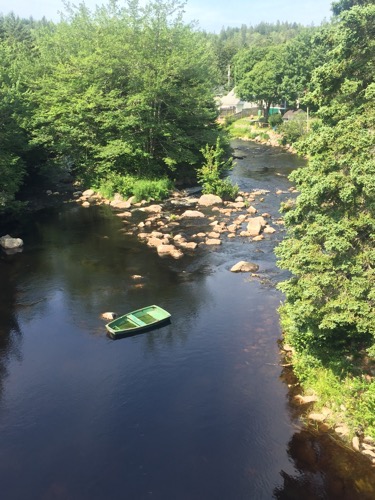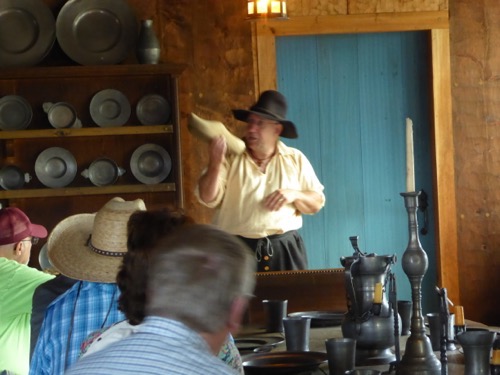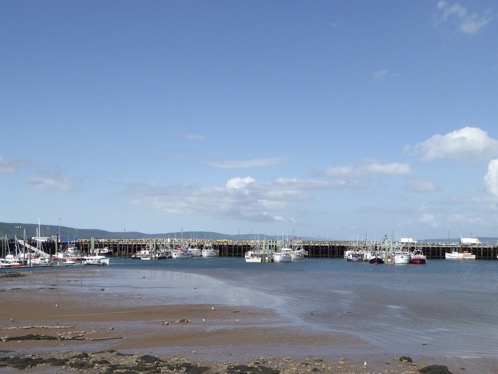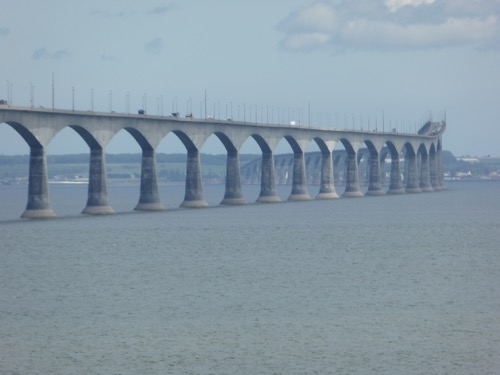
The rest of the day was spent showering, getting hair cuts and resting from the ride.
Traveling in our 35 foot Newmar Ventana RV plus a few planes ships & trains!

The rest of the day was spent showering, getting hair cuts and resting from the ride.
The bus dropped us off at the Maritime Museum of the Atlantic and then we were on our own to explore or shop or eat until around 2 PM. The museum was interesting as they had lots of models of all sorts of ships from the early 1700’s to modern cruise ships. We learned more about the Explosion of 1917, and more about naval history than we really wanted to know.
The board walk along the waterfront was busy with lots of shops, tour companies, and restaurants. It was nice to get out and stretch our legs in warm sunshine. We had a nice lunch at the Bicycle Thief then met the caravan for the highlight of my day - a ride on the Tall Ship Silva under full sail! Its a large 3 mast, 5 sails ship made of iron with a wood deck with seating for about 100 people. Some of the men and young boys got to help raise the sails but for safety reasons they still had the engines running the whole time. But it was so awesome!
Then, the highlight of John’s day, we had a fun brewery tour and tasting at Alexander Keith’s Brewery. They have been around for over 150 years and had some of the best beer we have tasted. According to the brewery the best way to experience their beer is with friends and music. The friends we had with us and the music was provided by the brewery. Good Irish tunes and a song from a Newfoundland group I have read about called The Great Big Sea. So much fun and laughter!
Caroline is a retired social studies teacher and has tons of dates memorized and ready to expound upon as our guide to Halifax. Most of the dates we had heard about from our other historical tours so I won’t go into them again. Halifax was settled in 1749 and was used by the British to protect the lower colonies from the French. At that time we were still under British rule.
Just a little bit of trivia about this region. Halifax has the second largest & deepest ice free harbor in the world (Sydney, Australia is #1). Nova Scotia mean New Scotland but was settled mainly by Dutch and Germans (Deutsch sounds like Dutch but means German) but there are a lot of Irish and Scotch influences. Lobster season runs from Nov. to May in this area. Average winter temperature is zero so if colder it snows and if warmer it rains, sleets then snows.
On our way to Peggy’s Cove we stopped at Canadian Maple Products and learned all about Maple syrup. 98% of maple sap is water, 85% of the world’s maple syrup comes from the Maritime Provinces. A maple tree is 50-75 years old before you can tap it for syrup but it can be tapped every year for up to 100 years and in Nova Scotia only 10% of the trees are tapped - that can be 20,000 trees in 118 acres or 150,000 trees somewhere else or 5,000 in your back yard. Forty gallons of sap will make 1 gallon of syrup. And of course I bought lots of syrup, maple candy and maple butter.
South of Halifax is an area along the Atlantic coast with numerous small bays like Terrance Bay, Shedd Bay and St. Margaret’s Bay where the tiny town of Peggy’s Cove is located. This used to be a fishing cove but is recognized today as an artist’s community and draws thousands of tourist every day. The story goes, in some form or another, that Peggy was the lone survivor of a shipwreck at this small cove before 1811. Bill Degarthe was the artist in residence and carved out a rock wall to depict the life of a fisherman who is in communion with God and protected by His angels.
We had a lovely walk about town, stuck our heads in a couple of shops then had lunch. The rocks surrounding the lighthouse have been worn smooth by the ocean waves and make a beautiful landscape and a fun place to climb. It was foggy all morning, seemed to lift at lunch time but it dropped back down before we could see the opposite shore. We did get some pretty pictures though.
It seems as if Halifax has seen it share of tragedy. We drove past the area where Swiss Air 111 crashed into the ocean killing all on board. Then we stopped at the Fairview Lawn Cemetery where victims of the Titanic are buried. The dead were brought to Halifax, some were buried at sea, some in their religious cemeteries (if known) and the majority were buried in Halifax. Some were identified but many were unknown.
Then on Dec. 6, 1917 at the beginning of WWI, a French ammo ship, the Mont Blanc, was coming into Halifax harbor to lay over before going to Europe. As it was passing through the narrowest point in the harbor another ship, the Imo full of medical supplies for the war, was coming out. The ammo ship clipped the other ship causing a gas spill on the ammo ship. As they pulled apart, sparks ignited the gas and 30 minutes later the largest man made explosion in the world blew a hole in the harbor and destroyed 2 km of the northern part of the city of Halifax, killing almost 2,000 people and injuring another 1,000. To this day this was the largest non-nuclear explosion in the world. The Mont Blanc was carrying almost 3000 tons of explosives.
Now on to more pleasant sights. We enjoyed a band playing blues music while we walked through The Public Gardens laid out as a Victorian style garden with exotic plants and lovely designs made of flowers.
Our last stop was the Halifax Citadel where we watched the changing of the guard and walked the ramparts before going into the museum. This fort sits high on a hill overlooking the city and harbor.
Saturday was a short travel day with a 60 mi. drive up the coast to the RV park on the outskirts of Halifax. And the campground wanted us all in our sites by noon. Once we got settled in, Mellow and Janet invited us to join them in going to Dartmouth.
This used to be a separate city from Halifax but once they built two bridges to connect the cities, it became one city but retained its name of Dartmouth. We crossed one bridge then enjoyed the waterfront area as they were celebrating the many cultures found in the city. We listened to some music, wondered through a shopping tent then enjoyed the many wonderful aromas coming from the food tent. There were foods from Jamaica, Africa, India, Nova Scotia, and several other nations. We then found our way back over the second bridge in time to share a dinner with the caravan. Good fried chicken, salads, and watermelon.
The oceans around the Maritime Provinces used to be teaming with cod. The continental shelf is the widest of any continent and has shallow water (if you call 200-250 ft. shallow) but it makes for a good fishing area. The Grand Banks of Newfoundland have some of the best fishing. Cod is not as plentiful these days as it was in the early part of the 1900’s but they are working to bring those number back up.
Three currents make this area great for fishing. The Labrador current brings cold water plankton down from the north, it mixes with the warm currents from the St. Lawrence river and the Gulf Stream in the Atlantic sweeps all the way up her bringing more food and fish.
Line fishing was the preferred method to catch cod in 1938. Lines up to 2 miles long filled with hooks would be dropped into the water with weights to pull them to the bottom then 3-4 times a day the dories of fishermen would go out, haul them up, remove the fish, rebait and drop it down again in some of the most horrible, cold conditions you can imagine. In 1962 the schooners were put ashore and steam ships with iron hulls and nets became the way to fish.
Because cod is not so plentiful, lobster and scallops is the industry today with cod imported from those who fish beyond the international waters.
Sable Island is a large sand bar off shore from Nova Scotia. It is called the Graveyard of the Atlantic due to the hundreds of ships hitting the sand and sinking. The winds on Sable are 18 mph or more all the time, the island is low and before technology ships could loose their way or be pushed by storms into the reefs. In 1927 over 12 ships were sunk in August of that year.
We enjoyed walking around Lunenburg, visiting a church that burned in 2001 and has been reconstructed to look exactly like it did before the fire. We also drove over to Mahone, another cute little harbor village.
Before we left Annapolis Royal we were able to tour a Lobster Plant. The lobster season in Nova Scotia runs from March to July and Oct. to Feb. Only the males are kept and they must be over 1 pound. All the females are thrown back to create more lobster. After the fishermen unload the lobster they are sorted by size and placed in crates or tubes and kept in 34° salt water where the lobster hibernates until it is time to package them and ship them off to all corners of the world. China, Japan, and Korea want the biggest ones or 6-9 pound size. This plant has 4 large tanks and each tank will hold 96,000 pounds of lobster.
We crossed from the north side of Nova Scotia to the south side, stopping for lunch in the Kejimkujik National Park (pronounced ‘ke-jim-ku-jik’). If it had not been raining and windy we were going to rent a kayak and explore their lake and river but the weather was horrible! Even at that, this is a park we would like to come and stay for awhile because there appeared to be a lot of hikes, biking and kayak opportunities.
Next stop is Lunenburg, not far from Halifax. It was very windy and raining all afternoon but we didn’t mind staying indoors and getting some computer work accomplished. We had a whole pound of fresh scallops for dinner - mouth watering good!
Port-Royal National Historical Site is a reconstruction of a 17th century French compound and was one of the earliest settlements in North America. In 1603 France tried to start a colony near hear but a severe winter and short supplies led to death for almost all of them. For two more years more men were sent and they settled on the protected cove where Port Royal now sits.
The reconstruction was done in 1938-1941 and replacements of roofs and a few other walls or floors has been done over the years but always using the same tools and materials available to the colonist in the 1600’s. The settlement looks like a fort but it was built this way to provide more protection from nature than from attacks. Rooms included the dining area with kitchen & bakery, a forge, chapel, and artisans quarters as well as residences for the general population and for the gentlemen who stayed. They also had a root cellar/store room and a wine cellar to keep the wine from freezing. There may also have been a trading room. The Mi’kmaq would have camped outside the settlement and helped the settlers with farming and fishing.

In the town of Annapolis Royal was the Fort Anne National Historic Site. The fort was a star shaped, earthen works structure with the buildings for the soldiers in the very center. Most of the buildings have burned down except for the Officer’s Quarters which serves as the museum and offices. A powder magazine and black hole are still visible.
Nearby is the Historic Gardens of Annapolis Royal. John’s tour of the gardens took 10 minutes while in the 45 minutes allowed I only saw part of the whole area! There are many beautiful roses, hydrangea, lilies and hostas, and flowers too numerous to count. Lilly ponds, pine forest, marsh lands and fountains. All on 17 acres. Very pretty.
Yesterday was just a nice quiet day for us. We did not get up early to ride the tidal bore, which they said was not really exciting, but we did ride our bikes on a lovely trail along the marsh lands that the Acadians created by building dykes to keep the sea water out.
Speaking of Acadians - today we visited the Grand-Pre ´ (pronounced Grand - pray) National Historic Site where we began learning about the people and history of this area beginning in 1604 when French colonists landed in this area and started to try and build a home for themselves. It was very rough in the beginning fighting the long, cold winters, scurvy, hunger and loneliness because these men were here without their families and had never experienced these conditions. But they persisted and around 1636 they made friends with the Mi’kmaq Indians, welcomed folks from other countries, eventually brought their families over and found this land to have rich soil and abundant wildlife to begin a new life. In about three generations they considered themselves Acadian and not French or English or Dutch.
Then the British decided they wanted this land and they began trying to make the Acadians swear aliegance to the crown, the French wanted them to be loyal to France but the Acadians just wanted to be left alone and declared they were neutral. From 1755-1763 there were 17 battles between the French and British and the land changed hands 7 times. In the end the British won and the Acadians were required to be British or they were deported back to France or down to the US colonies, some even to Louisiana and Jamaica. It was many years before they could return to Nova Scotia and by then the British had totally taken over their lands so they gave up farming and became fishermen.
Grand-Pre´ had few buildings to see since the British burned them all down. Henry W. Longfellow immortalized the plight of the Acadians in his epic poem “Evangeline”. A statue of her stands in a small chapel on the Grand-Pre´grounds.
In Annapolis Royal I learned much of the history of the Acadians during a candle light tour of the Graveyard at Fort Anne. Previous to that John and I drove to Digby which is famous for it scallops. We strolled around this little village before choosing a restaurant but there wasn’t a whole lot to see. Seems they roll up the sidewalks fairly early.

We are spending two nights in Hilden, Nova Scotia north of Halifax so that a few in our group can ride the tidal bore that comes up the end of the Bay of Fundi.
But first we had dinner at the Hilden Fire Brigade, prepared and served by the volunteer firemen. Very nice!
PEI is named after King George’s fourth son as the island was under British control beginning in 1763. In 1861 Canada gained their independence, in 1864 they became Confederation of Canada with providences and in 1873 PEI joined Canada as its smallest providence. The Confederation charter was put together and ratified in Charlottetown. C-town is sometimes referred to as the Philadelphia of Canada and PEI is the Kentucky of Canada because of all the horses. There are 152,000 people in the whole island. They are the 3rd largest grower of potatoes in North America. Back in the early part of the century, fox stoles were the rage so they raised foxes. When furs went out of style, the foxes were released into the wild. We were supposed to see them often but we never saw even one!
Our first stop of the day is at Cows Creamery Factory where we watched video’s of the making of ice cream and cheese and then ate a bowl or cone of the ice-cream of our choice. Yummy!
On our tour of Charlottetown we saw numerous churches, government buildings the harbor, many parks and busy downtown streets. The towers of St. Dustan Basilica Catholic Church grace the city skyline and no building can go higher than these towers. Surrounding the church are many other old churches like St. Paul’s Anglican Church built by ship builders so that the roof line is much like the hull of a ship. In Boulder park are large rocks from each of the providences and a memorial fountain. PEI has no rocks or other aggregate so almost all of their building materials are imported.
We were led on a walking tour by Sam who was dressed in period costume of 1864 when PEI joined the confederation. We walked around Providence House, the seat of PEI government, although it is undergoing a complete renovation so that all the offices are in surrounding buildings. He also told us about the history of the building of the Confederation Center for the Arts which is for all of Canada because each person in the country gave $.30 towards the cost of the building.
This is where we attended the musical production of “Anne of Green Gables” - the longest running annual musical in the world at 53 years and going strong. It was a professional production and very nicely done. I loved it, John didn’t fall asleep during it! Thats high praise!
 John went cod fishing this morning. They do this in the lobster boats that are otherwise unused for 10 months of the year. They started by fishing for mackerel to use for bait. that was fun as they caught 2 at a time and caught 100s of them. Then they moved to slightly deeper water for the cod. John caught 2 but one was under the 19” minimum length. Most did not catch any cod but is was an absolutely perfect day to be on the water. The locals swear the mackerel is better to eat than the cod so they left with 10 big bags of filets. The caravan will be having a fish fry sometime the next few days.
John went cod fishing this morning. They do this in the lobster boats that are otherwise unused for 10 months of the year. They started by fishing for mackerel to use for bait. that was fun as they caught 2 at a time and caught 100s of them. Then they moved to slightly deeper water for the cod. John caught 2 but one was under the 19” minimum length. Most did not catch any cod but is was an absolutely perfect day to be on the water. The locals swear the mackerel is better to eat than the cod so they left with 10 big bags of filets. The caravan will be having a fish fry sometime the next few days.
The bike ride, I’m sure you understand. It was 15 miles along the Gulf of St. Lawrence coastline. Such beautiful scenery of tall cliffs in the red sandstone, green fields of barley and potatoes outlined by pine trees, and the blue of the ocean reflected in the azure skies!
Now for Ceilidh. This is a Celtic word pronounced “kay - lee” and is a Scottish or Irish social gathering which usually involves Gaelic folk music, dancing and singing in a community gathering place. What we experienced was a very talented lady playing the fiddle, a guitarist/singer and an accordion-piano player-singer-comedian, and a Celtic dancer. They were fun, funny and wonderful musicians. If we had wanted to we could have find a Ceilidh every night somewhere on the island.